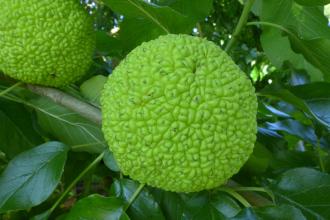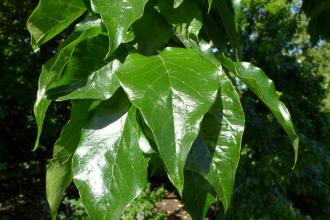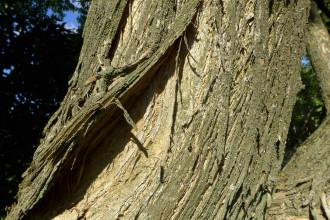
Maclura pomifera (19/09/2015, Kew Gardens, London)
Position: Full sun to partial shade
Soil: Moist, well drained
Flowering period: Mid summer
Eventual Height: 15m
Eventual Spread: 15m
Hardiness: 4a, 4b, 5a, 5b, 6a, 6b, 7a, 7b, 8a, 8b, 9a, 9b
Family: Moraceae
Maclura pomifera is a deciduous tree or large shrub with an upright/ pyramidal habit when young, becoming more open with age. Its glossy dark to mid green leaves are cordate with a sinuate margin, up to 12cm long and 6cm wide. Its leaves turn yellow in autumn before they fall. Its branches are green/ yellow to orange/ brown and are armed with thorns. Its trunk may achieve up to 3m in diameter. Its bark is a dark orange/ brown, shallowly fissured and often peels into long narrow strips. This tree is dioecious with the female inflorescence held in dense umbels of green flowers. The male are held in similar umbels of yellow flowers. Its fruit is sub globose, up to 15cm in diameter and composed of many tightly packed green drupes. Its lateral roots can grow at or above the soil level and the tap root can reach a depth of 8m.

Maclura pomifera Fruit (19/09/2015, Kew Gardens, London)
Maclura pomifera, commonly known as the Osage Orange, Bois D’Arc or Bowwood, is native to south central USA. In its native habitat it grows in mixed woodland, thickets and open grassland. The plant is highly prized for its wood. Maclura pomifera is synonymous with Toxylon pommifera and Maclura aurantiaca.
The etymological root of the binomial name Maclura was named for William Maclure (1763-1840), a Scottish geologist known as the ‘father of American geology’. Pomifera is from the Latin meaning ‘fruit bearing’.

Maclura pomifera Leaf (19/09/2015, Kew Gardens, London)
The landscape architect may find Maclura pomifera useful as an interesting specimen tree with unusual fruit. It may be used as a hedging species with glossy green leaves. It may be used as a component of a maritime planting scheme.
Ecologically, Maclura pomifera is of little value in the UK.

Maclura pomifera Bark (19/09/2015, Kew Gardens, London)
Maclura pomifera prefers moist, fertile, well-drained soils. It tolerates most pH of soil. It tolerates maritime conditions.
Maclura pomifera requires little maintenance.

Landscape Architecture

